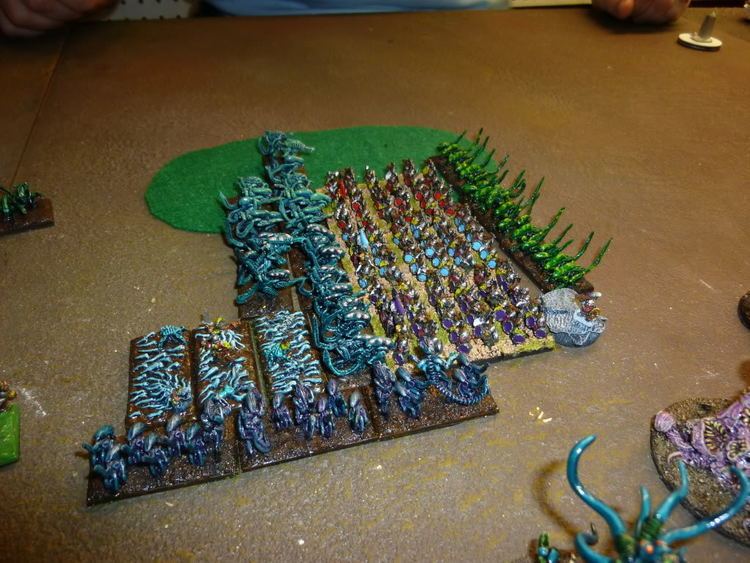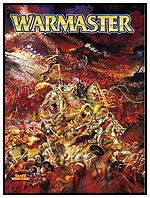Setup time 4–10 minutes | Age range 10+ Players 2+ | |
 | ||
Playing time | ||
Warmaster video hd
Warmaster is a ruleset for tabletop wargames written by Rick Priestley, published by Specialist Games (a division of Games Workshop), and set in the Warhammer Fantasy setting. It is different from Warhammer Fantasy Battles in both appearance and gameplay. It is intended for 10 –12 mm miniatures. Basic troops are based on stands, of which typically three make a unit. Generals, Heroes and Wizards are mounted individually or with their retinue.
Contents
- Warmaster video hd
- Warmaster orcs vs high elves and empire report
- Releases
- Battle of Five Armies
- Warmaster Ancients
- Warmaster Gameplay
- Warmaster Ancients gameplay
- Spin offs for other periods
- References

Gameplay focuses on command and control. While magic is used in the game, its effects on the game are limited. The game is designed to focus on the general's ability to command rather than just the armies ability to fight.

In the Warhammer 40,000 universe, Epic fills much the same "large scale battle" role as Warmaster does in Warhammer Fantasy, though the two systems do not share rules.

Warmaster orcs vs high elves and empire report
Releases

The original version, the fantasy ruleset Warmaster, was first released in 2000. As with most of the "specialist" games products, the support strategy from Games Workshop has evolved over time. Once a part of the Specialist Games division, Warmaster was then directly supported by Games Workshop itself, albeit at a reduced level. In 2013 Games Workshop stopped producing the miniatures and started to remove them from their webstore as stocks ran out. A freely downloadable "Living Rulebook", along with supplements and archived magazine articles, are available through the fan-administered site Specialist Games.
In mid-2006, a new online supplement was added to the Specialist Games website, known as Warmaster Armies. This supplement includes slightly revised lists for the six original armies (High Elves, Empire, Dwarfs, Chaos, Orcs and Goblins, and Tomb Kings of Khemri), alongside new lists for eight forces (Dark Elves, Skaven, Bretonnians, Lizardmen, Kislevites, Vampire Counts, Daemonic Hordes, and Araby).

This was followed in 2009 by a fan-based supplement release. This included a large number of alternative, trial or fan designed army lists. The Warmuster publication aims to promote ongoing development of the game.
In 2010 Warmaster 2nd Edition was released, which compiled and clarified the siege rules written for the game over the preceding 10 years.
Battle of Five Armies
In 2005 Games Workshop released a boxed game called Great Battles of Middle Earth: The Battle of Five Armies based on the battle from the book "The Hobbit". The rules are heavily based on Warmaster, and it uses the same miniature scale. The boxed set contains rules, plastic 10 mm miniatures, and scenery (Plastic hills, ruins and a cardboard river).
Additional miniatures for this game were cast in white metal. While detailed in the box set rule book, these extra miniatures were sold separately. They were discontinued shortly after being released. The box set remained in print for a longer while. It was removed before the launch of the 28 mm line based on the movie "The Hobbit: An Unexpected Journey".
Warmaster Ancients
Also in 2005 Warhammer Historical published Warmaster Ancients, a modified version of the Fantasy rules suitable for battles covering a period from early Biblical times to 1066. The rules are different from the original 'fantasy' version to better represent historical battles and units. Cavalry, for example, was made weaker in relation to infantry in favour of armies such as the Romans and the Norse.
October 2006 saw the release of Warmaster Ancient Armies, which includes 20 new army lists (all of which are set prior to 1000 AD), along with rules for campaign play and a number of new rule clarifications and unit modifications. The campaign rules have been described as a good way of linking battles, but are not suitable for historical campaigns.
A new ruleset for the Medieval period was released in December 2008. This ruleset has a number of significant differences with the Fantasy and Ancients version. Knights are introduced as a powerful unit shifting the game balance back towards cavalry, like in the original, Fantasy version. Special rules are provided for sieges, period equipment, and larger command elements called battles.
Warmaster Gameplay
Warmaster works at a higher organisation level than Warhammer Fantasy to represent very large battles in the Warhammer world. The components of an army are divided into two basic types: units and characters. In the original 10 mm Games Workshop-produced miniatures, figures are cast 5 men to a strip, though many gamers base their miniatures with other maker's figures to produce 4-12 figure-per-base bases in order to create a variety of mass effects. Standard bases for Warmaster Ancients are 40 mm x 20 mm elements. Units are normally made of three such elements each. Infantry are based along the 40 mm edge, while cavalry, chariots, monsters and artillery are based along the 20 mm edge. Characters represent commanders such as generals, heroes and wizards and may be based as the player desires, generally on round diorama-sculpted coins or 40 or 20mm wide bases in order for them to be included directly in combat alongside the troops.
Gameplay proceeds with the rolling of dice. Units in Warmaster must be activated and moved by rolling against the command value of a character; units can be activated multiple times, though the roll becomes progressively more difficult. If a commander fails his activation roll, he can no longer command units in that turn. Units may be moved into contact with enemy troops and are considered charging. To enable commanders to move their armies around, units can be formed into brigades of up to four units.
Once all units have been moved eligible units are allowed to shoot and wizards may attempt to cast a spell. Shooting is not very deadly, but any hits scored may force an enemy unit to fall back and cost the player further command rolls to draw back into combat. Shooting is therefore primarily aimed at disrupting enemy formation and cohesion rather than destroy them.
After the shooting phase follows the combat phase, all units involved in combat may roll a number of six-sided dice equivalent to their attack value. Units based along the 20 mm edge have a tremendous advantage against units based on the 40 mm edge, allowing them to pack all their attacks in a narrow frontage, with two units being able to combine their attacks onto a single enemy unit. Once two units have exchanged blows the number of hits are totalled. The loser with the lowest total hits is forced to fall back, while the winner has the option to stand, pursue or fall back. Fights may continue, even against multiple enemy units in succession, until one side is destroyed or the attacker does not wish to pursue the enemy.
Warmaster Ancients gameplay
Even before Warmaster Ancients were published, there had been attempts to use the fantasy rules for purely historical armies. However, they had significant drawbacks – cavalry under the fantasy rules were too powerful, skirmishers too weak and some historical troop types were not catered for at all.
The gameplay for Warmaster Ancients follows the same basic procedure as Warmaster Fantasy, but differs in the following way:
Spin-offs for other periods
Quite a few rulesets have been written using the basic warmaster mechanics.
